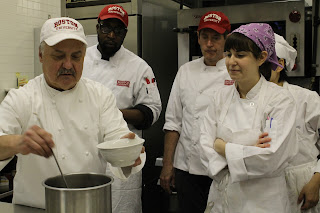January 17, 2012
Today was the first day of culinary class. The resources in the kitchen that we
have access to are amazing and I am looking very much forward to learning how
to use them and actually work with them.
Chef Vhynanek began teaching us about the basis for brown
sauces and the difference between a white and brown sauce/stock. I never really knew what the main
difference was. The basis for the
brown sauce are roasted bones that are browned, hence giving the stock the
brownish color, white sauces do not contain roasted bones. Furthermore, I knew that to make a
stock you need bones, celery, onion, and carrots. I was unaware of the 50% onion, 25% carrot, 25% celery ration
as well as the type of bones that are preferred in stock. Veal knuckles and cow necks (we
received bone marrow bones instead of neck which usually contains more meat).
Overall a great day, a lot of learning and I am looking
forward to working with the seven other students and the Chefs!
January 18, 2012
Stock day! We tackled chicken stock, fish stock, brown
stock, and court bouillon. Today I took on the role of Sue Chef for my
team. I know how to follow recipes
one at a time, but understanding how to manage time, assign tasks and to make
sure everything was getting done was a new concept for me. Instead of dicing carrots, celery and
onions for the chicken stock, I assigned Kim to cut all the onions for the
stocks, Franklin to dice the celery and to chop the chicken and fish and Sarah
to make the sachets. At times, we
all had to pick up where someone left off if they needed to skim the stock or
cut and clean the fish. It was a
stressful day since I usually am a planner and like to organize what needs to
be done. Being thrown into
managing without having time to really plan, exposed me how to think on my feet
and really work as a team. Even
though we were broken up into two groups, we all acted together to make the
cooking process as seamless and timely as possible.
Tasting, Smelling, Feeling the stocks – comparing them to
each other.
January 19, 2012
Today, we finally finished a few dishes - SOUPS. The process of making soups can range
from easy to the most intense and time-consuming procedures. Making the beef consommé
was eye opening to the possibilities out there to infuse flavors into
liquids. The broccoli soup also
was time consuming and making the roux and veloute needed patience and
needed to be perfect. The numerous
steps, procedures and ingredients that all go into some recipes are truly
amazing. I knew some recipes were
difficult and involve many steps, but I never really practiced any of these types
of recipes before. This class is
exposing me to not only the traditional French practices but also the skills,
the numerous layers of flavors and the time and effort needed in every step to
produce something amazing.
Furthermore, this class is giving me the opportunity to explore these
recipes that I would have normally skipped over. Oh and salting is important! I got perfects today on flavor and seasoning!
January 23, 2012
Poultry lesson.
We learned how to bone a chicken, take it apart, saute it roast it, bake
it, and braise it. The Chef’s
teaching style was very different than Chef V. He engaged more by walking around the room and checking on
everyone’s dishes. I have roasted,
braised, sauteed and baked chicken before, but to really understand the purpose
for each technique was fascinating.
Each part of the chicken was used in varying ways, each giving its
unique flavors to the dish. We made chicken breasts in white wine, shallot, thyme and mushroom sauce. We used the carcasses to make chicken stock, which we used in the chicken mushroom dish. My partner, Sarah and I roasted our chicken using lemon, onion, salt, pepper, and thyme. The chicken thighs were braised in a tomato, chipotle and "darkened onion and garlic" sauce. The thighs were served with homemade corn (masa) tortillas - so simple to make!
masa + hot water = play dough roll into circle, cook in hot cast iron skillet. The tacos were served with sour cream, cilantro and cabbage. Yummy!
Few pointers learned
- start cooking meat at room temp.
-chicken must be 165 degrees to be cooked
- Never stuff a bird - bacteria !! because the stuffing also has to reach 165, but then your bird dries out - boo
- feel for the joints when cutting up the chicken

















































